Papers by Valentina Rognoli
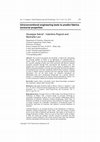
International Journal of Computer Aided Engineering and Technology, 2013
The research investigates the possibility of objectively anticipating the sensorial qualities of ... more The research investigates the possibility of objectively anticipating the sensorial qualities of fabrics as an opportunity for competitiveness in textiles' fields. To this end, three meaningful subjective sensorial perceptions for a specific sampling of fabrics have been associated with objective material properties measured through both conventional and alternative tests. The samples have been eventually assessed by three groups of panelists in three different sensorial modalities, involving touch and sight. Data from the physical and mechanical tests were then statistically related to these subjective rankings in order to identify objective properties that best anticipate specific sensorial information. Two are the main results: (a) subjective perceptions are independent from user's professional background; (b) a specific objective property is a reliable parameter for softness sensorial anticipation. Finally, a set of tools is proposed to exploit the potentiality of the obtained results.
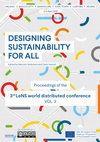
Design for Sustainability (DfS) focuses on wicked problems that cannot be modelled in reductionis... more Design for Sustainability (DfS) focuses on wicked problems that cannot be modelled in reductionist ways. Furthermore, when bottom-up local interventions prove to have positive effects in their context, they remain hard to spread and might face failure if transferred the other contexts. Here, a research through-design approach is present-ed for highlighting a new paradigm, that questions the very nature of both design process and outcomes. Specifically, Open-ended Design (OeD) is introduced pursuing the creation of unfinished and ever-evolving outcomes (im-perfect by intention), embracing the out-of control local instances. In this approach balance between openness and over-design is sought, to facilitate both the global diffusion of design outcomes and their local re-appropriation. The aim of the research is to highlight existing connections between OeD and DfS, listing its values and limitations through some reported cases. In conclusion, designers might start designing for emergen...
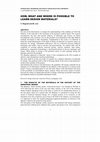
The aim of the dissertation is to deepen the understanding of the modality on which the Didactic ... more The aim of the dissertation is to deepen the understanding of the modality on which the Didactic of the materials in the formation of the designer could be based. The research encompasses the past and present didactic of materials and focuses on future developments with a cautious view on the possible cross-fertilization with other didactic methods developed in other disciplines. Fundamental to this scope is to illustrate in detail the actual phenomenon of the birth of library of materials as research centres on materials for design. Substantial differences will be evidenced between different typologies and reality, such as private and universitarian. An explicit table will be compiled of existing didactic material (books, experts, manuals, data banks, publications, magazines) formulating a classification based on diverse typologies and scopes. What needs to emerge is the potential utility of each typology during the formative period of the designer. The Bauhaus approach to material...
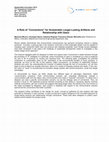
Recent studies demonstrate that environmental consciousness has garnered increasing interest in d... more Recent studies demonstrate that environmental consciousness has garnered increasing interest in design practices1. Currently, a growing idea in the research community is that sustainable design must be capable of changing users’ behavior2 rather than only products and materials properties. Even though several strategies have been developed in last years,3 the challenge of sustainable development needs to investigate a new holistic design-driven approach. The research highlights paths for designers to foster and support users’ involvement in waste reduction through the promotion of “R” strategies.4 In particular, active involvement of users is considered as a way to postpone the end of life of products by reusing and repairing them. The following paper investigates the potential contribution to sustainability given by the valorisation of the environmental benefits of reuse practices. In particular, we focus on the role of joint systems, called “connections”, as actuators of relations...
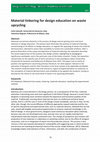
Materials are primary elements in the process of design and are gaining more and more attention i... more Materials are primary elements in the process of design and are gaining more and more attention in design education. The present work illustrates the practice of material tinkering, concentrating on its effects on design education, as regards the upcycling of waste into material demonstrators, deemed to assess their possibility to evolve into sustainable artefacts. After a general illustration of the scope and objectives of material tinkering, the exposition describes the recent experiences of this practice into design schools, highlighting its pedagogical significance worldwide, and in the particular case of the Italian situation. Finally, the exposition concentrates on the specific case of work carried out in two prestigious Italian Universities (Università di Camerino and Politecnico di Milano) from 2015. The paper tries to clarify its position and significance concerning previous literature, for what appears relevant to the education of designers and for their formation in the l...
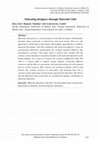
Proceedings of the 4th International Conference on Higher Education Advances (HEAd'18), Jun 20, 2018
Materials education is a crucial element in the field of design. Traditionally, learning about ma... more Materials education is a crucial element in the field of design. Traditionally, learning about materials is theoretical and book based. However, the appearance of Fab labs in universities add tangible opportunities to enhance materials knowledge. Fab labs combined with classroom didactics create an experimental dimension transforming the original material didactics into participatory activities. This paper aims to analyze how existing Fab lab systems can be reframed to maximize benefits in the material education in the design domain. As a result, we propose the concept of Materials Club. The club is a system made to support design students connecting different resources and facilities to experiment with materials during the development process of their projects. This scenario also promotes methods, which could valorize the existing resources in universities and integrate them into a virtuous system improving current design and material education. We believe that the Materials club can become an essential tool making contribution in materials education.
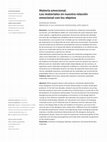
RChD: creación y pensamiento
Cuando interactuamos con productos, relaciones emocionales se activan. Los diseñadores deben ser ... more Cuando interactuamos con productos, relaciones emocionales se activan. Los diseñadores deben ser conscientes de estas relaciones para crear mejores y significativos productos. Durante las últimas dos décadas, una serie de investigaciones alrededor de las emociones que ocurren entre los productos y sus usuarios han revelado que los materiales juegan un papel importante en el desarrollo de estas relaciones emocionales. El presente artículo evidencia los diferentes antecedentes teóricos alrededor del tema de las emociones en el campo del diseño, focalizándose en la influencia que ejercen los materiales dentro de las relaciones emocionales que se crean entre los productos y quienes los utilizan. Adicionalmente, presentaremos dos clases de materiales emergentes conocidos como Materiales DIY y Materiales ICS, y la relevancia que estos representan en la disciplina del diseño gracias a la capacidad de convertirse en activadores emocionales, tanto en los usuarios como en quienes los crean. A...
Il valore dell'imperfezione. L'approccio wabi sabi al design (The value of imperfection. Wabi Sabi approach to Design)
ABSTRACT
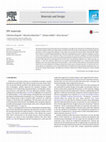
Materials & Design, 2015
The democratization of personal fabrication technologies in parallel to the rising desire of indi... more The democratization of personal fabrication technologies in parallel to the rising desire of individuals for personalizing their products offers great opportunities to experiment with advanced, distributed and shared production processes as well as design new materials. In this article, we introduce the notion of Do-It-Yourself (DIY) Materials, which are created through individual or collective self-production practices, often by techniques and processes of the designer's own invention. They can be totally new materials, modified, or further developed versions of existing materials. In order to provide an operational vocabulary to discuss DIY materials, we have collected 27 DIY material cases developed in the last five years. We group the collected cases under two main categories: (1) DIY new materials: which focus on creative material ingredients (e.g. a material made of dried, blended waste citrus peel combined with natural binders); and (2) DIY new identities for conventional materials: which focus on new production techniques, giving new expressions to existing materials (i.e. they do not necessarily contain new ingredients, such as 3D printed metal). Grounded on the commonalities of collected cases, we discuss the design opportunities, including new aesthetic impressions offered through DIY material design practices.
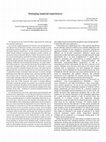
Materials & Design, 2015
Emerging material experiences into a body of work concerned with 'designerly' ways of using mater... more Emerging material experiences into a body of work concerned with 'designerly' ways of using materials to positively affect user experiences. A fascinating and complicating issue is that material experiences are not absolute. Using one material across multiple applications will result in a multitude of user experiences. Conversely, realizing one application through a variety of different materials will result in a different set of diverse experiences. Designers clearly have opportunity to effect desirable experiences through materials, though operationally this is far from straightforward. It implies that a designer's vocabulary and understanding of material properties should include both engineering (numerical/encoded) and experiential (sensorial/descriptive) perspectives, as well as a comprehension of their interrelations [5]. But this is only part of the concern. Designers must also have a firm grip on the ways in which materials lead to experiences, and how designing for material experiences can be embedded into routine design practice. By virtue of familiarity with the materials used, some material experiences are easier to comprehend and mobilize. However, the potential experiences of the unfamiliar, the unusual and the rare emerging materials are often challenging to envision and to design for. In the platforms where emerging materials are discussed (e.g. DiaBSmart, http://www.diabsmart.eu;DAMADEI, http:// www. damadei.eu; and Light.Touch.Matters, http://www.lighttouch-matters-project.eu), we see an ever increasing number of examples that illustrate challenging couplings of materials science, design, engineering and social sciences for a common purpose of 'design for meaningful material experiences' [6]. In other words, the borders between these professional disciplines fade as they work together on the common endeavour to find meaningful applications for a newly developed material at hand. In practical terms, this translates to a mutual respect and cooperation between communities, on the one hand, for the 'design of materials', and on the other hand, for the 'materials of design'. This evident duality of interpretation that the title Materials & Design admits provided the motivation for the journal editors to encourage the exploration of this topic through a series of studies included in the Special Issue. In fact, over the last decade, design communities are continually evolving their ability to contribute to the design of materials [7, 8], where materials experience studies and/or 'design-driven innovation' strategies [9] are proposed as a conceptual starting point in the material (driven) design process. Within this Special Issue we asked authors to prepare articles that collectively illustrate how 'emerging materials' can lead to new user experiences, drawing upon perspectives from design, social sciences, materials science and engineering. For this Special Issue the focus of the journal was deliberately shifted away from the technical issues of materials development towards personal and social implications of materials, asking questions such as: How do/will emerging materials
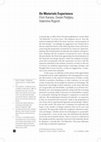
Design Issues, 2015
A decade ago, in 2003, Denis Doordan published an article titled "On Materials" in Design Issues.... more A decade ago, in 2003, Denis Doordan published an article titled "On Materials" in Design Issues. 1 His emphasis was on "how the material employed affects the form, function, and perception of the final design." Accordingly, he suggested a new framework to discuss materials based on the following three terms: fabrication, concerning the preparation of materials for initial use; application, dealing with transformation of materials into artifacts; and appreciation, dealing with the reception of materials by users. During the past decade, the third term appreciation has lured attention in the materials and design domain, which has adopted a broader sense that corresponds with the experiences we have with the materials embodied in the artifacts around us. It refers to the mix of sensory (or aesthetic) appreciations, meanings, feelings, and thoughts that we have toward-or that are triggered by-a material, at any certain time and place. In this essay, we elaborate on the notion of the appreciation of materials and its wider implications. Our starting point is a simple observation: In the material infrastructure of today's world, whether in products, buildings, or other creations, we see such variety of materials, driven largely by advances in technology. The layperson's knowledge of these materials, in the sense that they are recognizable and identifiable, is probably at an all-time low. 2 Similarly, new and emerging materials, along with the increasing demand to seriously adopt a discourse of sustainability, conspire to continually challenge the designer's competence in materials selection. The morphological character of materials-as expressive as they are functional and structural-leads to the proposition of new forms and an experimental approach toward design. 3 Materials are like words: The richer one's vocabulary (in materials), the larger is the number of design solutions that can be seen and expressed. 4 We argue that within the complexity inherent to materials and design-whether driven by technological or sustainability perspectives-users are the ones who determine the ultimate success (or not) of material choices. That is, success is a reflection of how people positively experience and react to the materials chosen by designers. A decade after "On Materials," this essay elaborates on the topic of materials experience. 5
How, what and where is possible to learn design materials

Reassess Injection Moulding Defects for Sustainability
Environmental issues nowadays are more urgent insomuch as a radical and prompt intervention is re... more Environmental issues nowadays are more urgent insomuch as a radical and prompt intervention is required [UNEP]. For this, the group has been investigating alternative strategies for reducing the environmental impacts of industrial products throughout their life cycle. This research has focused on the environmental potential hidden into the valorisation of design and manufacturing fault during the whole product’s life cycle, and specifically in the manufacturing process. These defects, connected to the each process, entail the removal of the product from the production chain, up to its elimination. Yet even EU directives on guarantees for consumer goods focused on the lack of conformity of products or ISO regulations are useful to support Quality Management System authorize and propose strategies for enhancement of the defective product. Therefore this research suggests the involvement of design for the optimization of defects in product design in order to extend the life of the product from the production stage, acting primarily on the aesthetic and functional level. The method used begins with the identification of possible defects, examining the injection moulding process as a case study. The defects collected were analyzed critically and creatively.
The aesthetical and sensorial characterization of design materials
1 st International Meeting of Science and technology of …, 2003

Le neuroscienze per il design: la dimensione emotiva del progetto (2009) Neurosciences for design: the emotional side of design
"L'emozione è potenzialmente insita in ogni oggetto. Il designer deve dunque prendere c... more "L'emozione è potenzialmente insita in ogni oggetto. Il designer deve dunque prendere coscienza del fatto che la dimensione emotiva degli oggetti fisici può (e deve) essere progettata. Nel dibattito attuale intorno al design il tema delle emozioni ricopre un ruolo di particolare attenzione da parte di numerosi attori. Si parla infatti di emozioni secondo numerosi e differenti punti di vista, da quello, potremmo dire, prevalentemente "filosofico" a quello con un più spiccato orientamento al design strategico o al marketing. Ciò che viene proposto in questo libro è un approccio neuroscientifico ai meccanismi emotivi. Esso ci consente di parlare anche di pensieri, di empatia e di stilemi, concetti fortemente correlati a quello più generale e più comunemente diffuso di emozione. Grazie alle neuroscienze, infatti, possiamo proporre approcci di metodo propri di questa disciplina, cercando in questo modo di descrivere ciò che avviene ad esempio nel sistema mente-cervello di un designer nel momento della creazione di un artefatto, o in quello di un utente quando con quel prodotto entra in relazione. Confidiamo così di solleticare interesse e destare curiosità nella mente di chi, designer o ingegnere, giovane studente o affermato professionista, abbia a cuore una colta e trasversale diffusione della cultura del progetto, soprattutto nella sua ormai imprescindibile dimensione di reciproco scambio e politecnico dialogo fra design, ingegneria e scienza."

Materiali per il design : espressività e sensorialità (2005) Materials for design: expression and sensoriality
Da sempre l’uomo si è confrontato con la fisicità della materia modificandola, così come il proge... more Da sempre l’uomo si è confrontato con la fisicità della materia modificandola, così come il progettista si è misurato con l’espressività dei materiali, trasformandoli e applicandoli con crescente consapevolezza nel percorso progettuale. Nel panorama contemporaneo del progetto si riscontra la necessità a utilizzare il materiale per valorizzare le potenzialità di arricchimento dell’esperienza sensoriale degli oggetti. La ricchezza delle qualità espressive della materia possono e devono essere progettate. Il libro muove da un’indagine esplorativa sul quadro multidisciplinare della dimensione espressivo-sensoriale dei materiali e sfocia nella proposta di un Atlante, offerto come luogo d’incontro fra due linguaggi, che coniuga le possibilità di percezione e associazione tipiche della cultura del progetto con il rigore e la linearità proprie del sapere tecnico e dell’ingegneria dei materiali

Il progetto della natura. Gli strumenti della Biomimesi per il design (2009) Design of Nature: the biomimetic tools for design
"La Natura è assimilabile ad un pregevole progetto, frutto di processi evolutivi perpetuatis... more "La Natura è assimilabile ad un pregevole progetto, frutto di processi evolutivi perpetuatisi per quasi 4 miliardi di anni, tali per cui la continua ottimizzazione degli organismi ha generato materiali, strutture e meccanismi di mirabile efficacia, spesso superiore ai corrispondenti artefatti umani, soprattutto dal punto di vista ambientale. Il libro, Il Progetto della Natura, è il risultato del percorso di ricerca per la diffusione dell'approccio biomimetico nella progettazione, che trae ispirazione proprio dagli organismi naturali per la realizzazione di prodotti e processi avanzati in molteplici livelli (prestazionale, tecnologico, ambientale, economico...) e ambiti applicativi (prodotti industriali, tessile e abbigliamento, architettura e costruzioni). Le potenzialità dell'approccio biomimetico vengono illustrate attraverso una vasta esemplificazione dei casi applicativi ed espedienti più significativi. La trattazione del tema comprende inoltre una panoramica sugli approcci, le istituzioni di maggior rilievo e gli strumenti basilari per avviare la progettazione bioispirata attraverso l'indicazione di riviste specializzate, blog di divulgazione e scambio, nonché database mirati a sostenere i progettisti della prossima "era biomorfica"."

Il valore dell'imperfezione. L'approccio wabi sabi al design (2011) The value of imperfection
Gli artefatti sono intrinsecamente destinati ad accompagnare la vita degli individui, contribuend... more Gli artefatti sono intrinsecamente destinati ad accompagnare la vita degli individui, contribuendo a palesarne l'identità. Sono entità vive e mutevoli, che possono cambiare dinamicamente il loro aspetto o perfino la loro funzione. Così come rughe, cicatrici o nèi costituiscono una testimonianza del passaggio del tempo e delle esperienze per l'uomo, analogamente usura, ingiallimento e difetti sono sintomatici dell'evoluzione e dell'unicità dell'artefatto. Le imperfezioni divengono elementi narrativi, che raccontano il vissuto specifico dell'artefatto, le sue peculiarità e l'uso che ne è stato fatto. Così l'imperfezione diviene un valore da ricercare, come era avvenuto in Oriente con l'influsso del wabi sabi, la "bellezza delle cose mutevoli, imperfette e temporanee". "Imperfetto" è assunto come sinonimo di reale, naturale, inevitabile, umano. Attribuire valore all'imperfezione significa progettare prodotti capaci di invecchi...







Uploads
Papers by Valentina Rognoli
MaDe, a project co-funded by the Creative Europe Programme of The European Union, aims at boosting talents towards circular economies across Europe partnering with design and cultural institutions, Elisava, Ma-tt-er and Politecnico di Milano.
Le imperfezioni divengono elementi narrativi, che raccontano il vissuto specifico dell'artefatto, le sue peculiarità e l'uso che ne è stato fatto. Così l'imperfezione diviene un valore da ricercare, come era avvenuto in Oriente con l'influsso del wabi sabi, la "bellezza delle cose mutevoli, imperfette e temporanee". "Imperfetto" è assunto come sinonimo di reale, naturale, inevitabile, umano.
Attribuire valore all'imperfezione significa progettare prodotti capaci di invecchiare, di modificarsi, di essere riparati; significa stimolare il legame emotivo tra utente e prodotto, allungarne il ciclo di vita e, soprattutto, accettare la presenza di una variabile non controllabile che spesso "cambia il finale del racconto".
Il libro indaga il valore attribuibile alle imperfezioni degli oggetti, proponendole come sintomi di un'inequivocabile unicità, fautrici del rafforzamento del legame emotivo, nel tempo e nello spazio, in una dialettica fra passato e contemporaneità, fra cultura orientale e fermento occidentale.